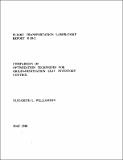| dc.contributor.author | Williamson, Elizabeth Louise | en_US |
| dc.contributor.other | Massachusetts Institute of Technology. Flight Transportation Laboratory | en_US |
| dc.date.accessioned | 2012-01-06T22:22:27Z | |
| dc.date.available | 2012-01-06T22:22:27Z | |
| dc.date.issued | 1988 | en_US |
| dc.identifier | 24933828 | en_US |
| dc.identifier.uri | http://hdl.handle.net/1721.1/68090 | |
| dc.description | Cover title | en_US |
| dc.description | May 1988 | en_US |
| dc.description | Also issued as an M.S. thesis, Massachusetts Institute of Technology, Dept. of Civil Engineering, 1988 | en_US |
| dc.description | Includes bibliographical references (p. 125-126) | en_US |
| dc.description.abstract | Airlines have recently realized the importance of an effective seat inventory control system on revenues and profits. Yet, at the same time, there is a lack of practical optimization models for determining the number of seats to allocate to each origin-destination and fare class itinerary in an airline's network. In this thesis, several different mathematical models and optimization techniques for origin-destination seat inventory control are evaluated and compared. Each technique is applied to a small network with assumed demand levels and fares for each O-D/fare class combination. The techniques are then compared with respect to the differences in seat allocations and booking limits, fare class nesting order and total potential system revenue. The "optimal" seat allocation solution is found by the probabilistic linear programming technique, but actual use of such a method is impractical due to the size of its formulation and its distinct inventory solution, which is not compatible with the nested reservations systems of most major airlines today. The technique that seems to have the most potential as an efficient origin-destination seat inventory control method is a network based deterministic linear programming technique, with seat allocations nested according to shadow prices. | en_US |
| dc.format.extent | 169 p | en_US |
| dc.publisher | [Cambridge, Mass. : Massachusetts Institute of Technology], Flight Transportation Laboratory, [1988] | en_US |
| dc.relation.ispartofseries | FTL report (Massachusetts Institute of Technology. Flight Transportation Laboratory) ; R88-2 | en_US |
| dc.subject | Airlines | en_US |
| dc.subject | Aeronautics, Commercial | en_US |
| dc.subject | Management | en_US |
| dc.subject | Mathematical models | en_US |
| dc.subject | Reservation systems | en_US |
| dc.subject | Passenger traffic | en_US |
| dc.title | Comparison of optimization techniques for origin-destination seat inventory control | en_US |
| dc.type | Technical Report | en_US |
